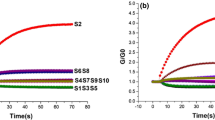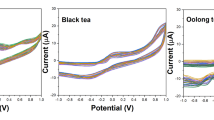Abstract
A simple and efficient fingerprint analysis method was developed and validated for the quality consistency control and authentication of Deepure instant pu-erh tea within different manufacturers using high-performance liquid chromatography (HPLC) coupled with chemometrics. To compare the HPLC fingerprint chromatograms between batches, varieties and manufacturers, the correlation coefficients of similarities of 60 samples and the relative peak areas of 11 characteristic compounds were calculated. Different pattern recognition procedures, including hierarchical cluster analysis, principal component analysis and partial least squares discriminant analysis, were then applied to classify the instant pu-erh tea samples according to their variety and manufacturer. Results showed that the developed method has potential application for the quality consistency evaluation and discrimination of instant pu-erh tea samples from similar products.




Similar content being viewed by others
References
Alasalvar C, Pelvan E, Ozdemir KS, Kocadagli T, Mogol BA, Pasli AA et al (2013) Compositional, nutritional, and functional characteristics of instant teas produced from low- and high-quality black teas. J Agric Food Chem 61:7529–36
Bougeard S, Hanafi M, Qannari EM (2008) Continuum redundancy–PLS regression: a simple continuum approach. Comput Stat & Data Ana 52:3686–3696
Chen FF, Qi HY, Shi YP (2013) Fingerprint analysis of codonopsis radix by HPLC coupled with chemometrics analysis. Chin Herbal Med 5:307–312
Chen Y, Zhu SB, Xie MY, Nie SP, Liu W, Li C et al (2008) Quality control and original discrimination of Ganoderma lucidum based on high-performance liquid chromatographic fingerprints and combined chemometrics methods. Anal Chim Acta 623:146–156
Ding Y, Wu EQ, Liang C, Chen J, Tran MN, Hong CH et al (2011) Discrimination of cinnamon bark and cinnamon twig samples sourced from various countries using HPLC-based fingerprint analysis. Food Chem 127:755–760
Gong JS, Tang C, Peng CX (2012) Characterization of the chemical differences between solvent extracts from Pu-erh tea and Dian Hong black tea by CP–Py–GC/MS. J Anal Appl Pyrol 95:189–197
Goodarzi M, Russell PJ, Vander Heyden Y (2013) Similarity analyses of chromatographic herbal fingerprints: a review. Anal Chim Acta 804:16–28
Haas D, Pfeifer B, Reiterich C, Partenheimer R, Reck B, Buzina W (2013) Identification and quantification of fungi and mycotoxins from Pu-erh tea. Int J of Food Microbiol 166:316–322
He X, Li J, Zhao W, Liu R, Zhang L, Kong X (2015) Chemical fingerprint analysis for quality control and identification of Ziyang green tea by HPLC. Food Chem 171:405–411
Kannel PR, Lee S, Kanel SR, Khan SP (2007) Chemometric application in classification and assessment of monitoring locations of an urban river system. Anal Chim Acta 582:390–399
Kong W, Wang J, Zang Q, Xing X, Zhao Y, Liu W et al (2011) Fingerprint–efficacy study of artificial Calculus bovis in quality control of Chinese materia medica. Food Chem 127:1342–1347
Lee LK, Foo KY (2013) Recent advances on the beneficial use and health implications of Pu-Erh tea. Food Res Int 53:619–628
Li Y, Wu T, Zhu J, Wan L, Yu Q, Li X et al (2010) Combinative method using HPLC fingerprint and quantitative analyses for quality consistency evaluation of an herbal medicinal preparation produced by different manufacturers. J Pharmaceut Biomed 52:597–602
Liu X, Wu Z, Yang K, Ding H, Wu Y (2013) Quantitative analysis combined with chromatographic fingerprint for comprehensive evaluation of Danhong injection using HPLC-DAD. J Pharmaceut and Biomed 76:70–74
Liu J, Li Q, Dong J, Chen J, Gu G (2008) Multivariate modeling of aging in bottled lager beer by principal component analysis and multiple regression methods. J Agric Food Chem 56:7106–7112
Lv HP, Zhong QS, Lin Z, Wang L, Tan JF, Guo L (2012) Aroma characterisation of Pu-erh tea using headspace-solid phase microextraction combined with GC/MS and GC–olfactometry. Food Chem 130:1074–1081
Lv SD, Wu Y, Li CW, Xu YQ, Liu L, Meng QX (2014a) Comparative analysis of Pu-erh and Fuzhuan teas by fully automatic headspace solid-phase microextraction coupled with gas chromatography–mass spectrometry and chemometric methods. J Agric Food Chem 62:1810–1818
Lv SD, Wu Y, Zhou J, Lian M, Li C, Xu YQ et al (2014b) The study of fingerprint characteristics of Dayi Pu-Erh tea using a fully automatic HS-SPME/GC-MS and combined chemometrics method. PLoS One 9:e116428
Ma T, Huang C, Meng X, Zhang Q, Zhang L, Lv X et al (2011) Fingerprint analysis of Hawk-tea by high-performance liquid chromatography. Food Chem 129:551–556
Park DJ, Imm JY, Ku KH (2001) Improved dispersibility of green tea powder by microparticulation and formulation. J Food Sci 66:793–798
Peng L, Song X, Shi X, Li J, Ye C (2008) An improved HPLC method for simultaneous determination of phenolic compounds, purine alkaloids and theanine in Camellia species. J Food Compos Anal 21:559–563
Pierce KM, Hope JL, Johnson KJ, Wright BW, Synovec RE (2005) Classification of gasoline data obtained by gas chromatography using a piecewise alignment algorithm combined with feature selection and principal component analysis. J Chromatogr A 1096:101–110
Sinija VR, Mishra HN, Bal S (2007) Process technology for production of soluble tea powder. J Food Eng 82:276–283
Sinija VR, Mishra HN (2009) FT-NIR spectroscopy for caffeine estimation in instant green tea powder and granules. LWT-Food Sci Technol 42:998–1002
Someswararao C, Srivastav PP (2012) A novel technology for production of instant tea powder from the existing black tea manufacturing process. Innov Food Sci Emerg 16:143–147
Wang Y, Li Q, Wang Q, Li Y, Ling J, Liu L et al (2012) Simultaneous determination of seven bioactive components in oolong tea Camellia sinensis: quality control by chemical composition and HPLC fingerprints. J Agric Food Chem 60:256–260
Xu CJ, Liang YZ, Chau FT, Heyden YV (2006) Pretreatments of chromatographic fingerprints for quality control of herbal medicines. J Chromatogr A 1134:253–259
Yan SK, Xin WF, Luo GA, Wang YM, Cheng YY (2005) An approach to develop two-dimensional fingerprint for the quality control of Qingkailing injection by high-performance liquid chromatography with diode array detection. J Chromatogr A 1090:90–97
Yang LW, Wu DH, Tang X, Peng W, Wang XR, Ma Y et al (2005) Fingerprint quality control of Tianjihuang by high-performance liquid chromatography–photodiode array detection. J Chromatogr A 1070:35–42
Yi T, Zhu L, Peng WL, He XC, Chen HL, Li J et al (2015) Comparison of ten major constituents in seven types of processed tea using HPLC-DAD-MS followed by principal component and hierarchical cluster analysis. LWT-Food Sci Technol 62:194–201
Yi LZ, Yuan DL, Liang YZ, Xie PS, Zhao Y (2007) Quality control and discrimination of pericarpium citri reticulatae and pericarpium citri reticulatae viride based on high-performance liquid chromatographic fingerprints and multivariate statistical analysis. Anal Chim Acta 588:207–215
Yu P (2005) Applications of Hierarchical Cluster Analysis (CLA) and Principal Component Analysis (PCA) in Feed Structure and Feed Molecular Chemistry Research, Using Synchrotron-Based Fourier Transform Infrared (FTIR) Microspectroscopy. J Agric Food Chem 53:7115–7127
Zhao ZJ, Pan YZ, Liu QJ, Li XH (2013) Exposure assessment of lovastatin in Pu-erh tea. Int J Food Microbiol 164:26–31
Zhao YL, Fan RH, Yuan HX, Yu M, Bi KS, Yu ZG (2011) Development of the fingerprints for the quality evaluation of Viscum coloratum by high Performance liquid chromatography. J Pharmaceut Ana 1:113–118
Zhou W, Xie MF, Zhang XY, Liu TT, Yu YJ, Duan GL (2011) Improved liquid chromatography fingerprint of fat-soluble Radix isatidis extract using multi-wavelength combination technique. J Sep Sci 34:1123–1132
Zhou X, Tang L, Wu H, Zhou G, Wang T, Kou Z et al (2015) Chemometric analyses for the characterization of raw and processed seeds of Descurainia sophia (L.) based on HPLC fingerprints. J Pharmaceut Biomed 111:1–6
Acknowledgments
This work was supported by the Yunnan Tasly Deepure Biological Tea Group Co., Ltd. (Simao, Yunnan, China).
Author information
Authors and Affiliations
Corresponding author
Ethics declarations
Conflict of Interest
Chao Wang declares that he has no conflict of interest. Chen-Xia Zhang declares that she has no conflict of interest. Chun-Fu Shao declares that he has no conflict of interest. Chang-Wen Li declares that he has no conflict of interest. Shun-Hang Liu declares that he has no conflict of interest. Xiao-Pei Peng declares that he has no conflict of interest. Yong-Quan Xu declares that she has no conflict of interest.
Ethical Approval
This article does not contain any studies with human participants or animals performed by any of the authors.
Informed Consent
Informed consent was obtained from all individual participants included in the study.
Electronic Supplementary Material
Below is the link to the electronic supplementary material.
ESM 1
(DOCX 1861 kb)
Rights and permissions
About this article
Cite this article
Wang, C., Zhang, CX., Shao, CF. et al. Chemical Fingerprint Analysis for the Quality Evaluation of Deepure Instant Pu-erh Tea by HPLC Combined with Chemometrics. Food Anal. Methods 9, 3298–3309 (2016). https://doi.org/10.1007/s12161-016-0524-4
Received:
Accepted:
Published:
Issue Date:
DOI: https://doi.org/10.1007/s12161-016-0524-4




